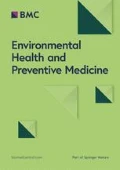Abstract
Chironomid midges have been revealed to be a hazardous inhalant antigen of bronchial asthma. To determine the awareness of the negative impact of chironomid midges (Chironomus plumosus and Propsilocerus akamusi) among patients, a questionnaire survey of 118 patients in the Lake Suwa area and in the Matsumoto area was conducted from early September to mid-November of 1993. The life style was almost the same among the asthmatic patients in the Lake Suwa area and in the Matsumoto area, but the reactions to the nuisance differed significantly from each other. Although “Flight density” was higher in the Lake Suwa area (p < 0.01) than that in the Matsumoto area, 25.5% of the patients in the Lake Suwa area and 9.1% of those in the Matsumoto area answered “Endurable” (p < 0.01). Further follow-up studies including prick tests, intradermal tests and provocation tests should be conducted for patients who complained a strong allergic reaction.
Similar content being viewed by others
References
Armitage PD. Chironomidae as Food.In: Armitage PD, Cranston PS, Pinder LCV, editors. The Chironomidae -Biology and Ecology of Non-biting Midges-. London: Chapman & Hall, 1995:423–35.
Ali A. Nuisance chironomids and their control (A review). Esa Bull 1980;26:3–16.
Ali A. Nuisance, Economic Impact and Possibilities for Control.In: Armitage PD, Cranston PS, Pinder LCV, editors. The Chironomidae - Biology and Ecology of Non-biting Midges-. London: Chapman & Hall, 1995:339–64.
Tabaru Y, Moriya K, Ali A. Nuisance midges (Diptera: Chironomidae) and their control in Japan. J Am Mosq Cont Assoc 1987;3:45–8.
Cranston PS. Medical Significance.In: Armitage PD, Cranston PS, Pinder LCV, editors. The chironomidae -Biology and Ecology of Non- biting Midges-. London: Chapman & Hall, 1995:365–84.
Kimura H, Matsuoka H, Ishii A. ELISA inhibition method in detection of mite and chironomid antigens in environmental samples of dust, soil and air. Allergy 1990;45:167–73.
Hirabayashi K. Studies on massive flights of chironomid midges (Diptera: chironomidae) as nuisance insects and plans for their control in the Lake Suwa Area, Central Japan. -2. Quantitative evaluations of the nuisance of chironomid midges-. Jpn J Hygiene 1991b;46:662–75.
Hirabayashi K, Okino T. Massive flights of chironomid midges (Diptera) as nuisance insects around a hyper-eutrophic lake in Japan -A questionnaire survey to tourists-. J Kansas Entomol Assoc 1998; (accepted).
Hirabayashi K, Kubo K, Yamaguchi S, Fujimoto K, Murakami G, Nasu Y, Studies of bronchial asthma induced by chironomid midges (Diptera) around a hypereutrophic lake in Japan. Allergy 1997;52:188–95.
Yamagishi H, Fukuhara H. Ecological studies on chironomids in Lake Suwa, 1. Population dynamics of two large chironomids,Chironomus plumosus L. andSpaniotoma akamusi Tokunaga. Oecologia 1971;7: 309–27.
Hirabayashi K. Studies on massive flights of chironomid midges (Diptera: chironomidae) as nuisance insects and plans for their control in the Lake Suwa Area, Central Japan. -3. Some experimental trials for control of nuisance midges and proposed counterplans-. Jpn J Hygiene 1991c;46:676–87.
Hirabayashi K, Nakazato R, Nasu Y, Okino T, Murayama N. Ecological studies on adult midges of chironomidae. -1. Resting habit of adult midges ofTokunagayusurika akamusi (Diptera: chironomidae). Jpn J Environ Entomol Zool 1992;4:71–7.
Hirabayashi K, Nakazato R, Ohara A, Okino T. A study on phototaxis for adult chironomidae (Diptera) by artificial light in Lake Suwa. - Response of adult chironomid midges to near ultraviolet and visible light-. Jpn J Sanit Zool. 1993a;44:33–9.
Hirabayashi K, Nakazato R, Ohara A, Okino T. A study on phototaxis for adult chironomidae (Diptera) by artificial light in Lake Suwa. -2. Effect of the light trap intensity and interval of electric collecting- killing insect traps using near-ultraviolet radiation-. Jpn J Sanit Zool. 1993b;44:299–306.
Hirabayashi K, Nakazato R, Okino T. Field trial trapping control method of chironomid midges (Propsilocerus akamusi: Diptera) by being attracted to high-intensity lighting. Jpn J Environ Entomol Zool 1998;9:8–15.
Sasa M, Kikuchi M. Chironomidae (Diptera) of Japan. Tokyo: University of Tokyo Press, 1995.
Robinson WH. Urban entomology -Insect and mite pests in the human environment-. London: Chapman & Hall, 1996.
Edington JM, Edington MA. Insect Nuisances.In: Edington JM, Edington MA, editors. Ecology, Recreation and Tourism. Cambridge: Cambridge University press, 1985:118–34.
Ali A. Perspectives on management of pestiferous chironomidae (Diptera), an emerging global problem. J Am Mosq Cont Assoc 1991;7:260–81.
Kagen SL, Yunginger JW, Johnson R. Lake fly allergy: incidence of chironomid sensitivity in an atopic population. J Allergy Clin Immunol. 1984;73:187 (abstract).
Ito K, Miyamoto T, Shibuya T, Kamei K, Mano K, Taniai T,et al.. Skin test and radioallergosorbent test with extracts of larval and adult midges ofTokunagayusurika akamusi T. (Diptera: Chironomidae) in asthmatic patients of the metropolitan area of Tokyo. Annals of Allergy. 1986;57:199–204.
Igarashi T, Murakami G, Adach Y, Matsuno M, Saeki Y, Okada T,et al.. Common occurrence in Toyama of bronchial asthma induced by chironomid midges. Jpn J Exp Med 1987;57:1–9.
Kino T, Chihara H, Fukuda K, Sasaki Y, Shogaki Y, Oshima S. Allergy to insects in Japan. III.High frequency of IgE antibody responses to insects (moth, butterfly, caddis fly, and chironomid) in patients with bronchial asthma and immunochemical quantitation of the insect-related airborne particles smaller than 10 μm in diameter. J Allergy Clin Immunol. 1987;79:857–66.
Hirabayashi K. Studies on massive flights of chironomid midges (Diptera: chironomidae) as nuisance insects and plans for their control in the Lake Suwa Area, Central Japan. -1. Occurrence of massive flights ofTokunagayusurika akamusi-. Jpn J Hygiene 1991a;46:652–61.
Author information
Authors and Affiliations
Corresponding author
Rights and permissions
About this article
Cite this article
Hirabayashi, K., Kubo, K., Yamaguchi, S. et al. Survey on negative impact of chironomid midges (Diptera) on bronchial asthmatic patients in a hyper-eutrophic lake area in Japan. Environ Health Prev Med 3, 37–43 (1998). https://doi.org/10.1007/BF02931237
Received:
Accepted:
Issue Date:
DOI: https://doi.org/10.1007/BF02931237



